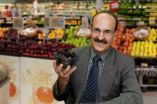(Press-News.org) Organic semiconductors hold immense promise for use in thin film and flexible displays – picture an iPad you can roll up – but they haven't yet reached the speeds needed to drive high definition displays. Inorganic materials such as silicon are fast and durable, but don't bend, so the search for a fast, durable organic semiconductor continues.
Now a team led by researchers at Stanford and Harvard universities has developed a new organic semiconductor material that is among the speediest yet. The scientists also accelerated the development process by using a predictive approach that lopped many months – and could lop years – off the typical timeline.
For the most part, developing a new organic electronic material has been a time-intensive, somewhat hit-or-miss process, requiring researchers to synthesize large numbers of candidate materials and then test them.
The Stanford and Harvard-led group decided to try a computational predictive approach to substantially narrow the field of candidates before expending the time and energy to make any of them.
"Synthesizing some of these compounds can take years," said Anatoliy Sokolov, a postdoctoral researcher in chemical engineering at Stanford, who worked on synthesizing the material the team eventually settled on. "It is not a simple thing to do."
Sokolov works in the laboratory of Zhenan Bao, an associate professor of chemical engineering at Stanford. They are among the authors of a paper describing the work, published in the Aug. 16 issue of Nature Communications. Alán Aspuru-Guzik, an associate professor of chemistry and chemical biology at Harvard, led the research group there and directed the theory and computation efforts.
The researchers used a material known as DNTT, which had already been shown to be a good organic semiconductor, as their starting point, then considered various compounds possessing chemical and electrical properties that seemed likely to enhance the parent material's performance if they were attached.
They came up with seven promising candidates.
Semiconductors are all about moving an electrical charge from one place to another as fast as possible. How well a material performs that task is determined by how easy is it for a charge to hop onto the material and how easily that charge can move from one molecule to another within the material.
Using the expected chemical and structural properties of the modified materials, the Harvard team predicted that two of the seven candidates would most readily accept a charge. They calculated that one of those two was markedly faster in passing that charge from molecule to molecule, so that became their choice. From their analysis, they expected the new material to be about twice as fast as its parent.
Sokolov, the Stanford researcher, said it took about a year and a half to perfect the synthesis of the new compound and make enough of it to test. "Our final yield from what we produced was something like 3 percent usable material and then we still had to purify it."
When the team members tested the final product, their predictions were borne out. The modified material doubled the speed of the parent material. For comparison, the new material is more than 30 times faster than the amorphous silicon currently used for liquid crystal displays in products such as flat panel televisions and computer monitors.
"It would have taken several years to both synthesize and characterize all the seven candidate compounds. With this approach, we were able to focus on the most promising candidate with the best performance, as predicted by theory," Bao said. "This is a rare example of truly 'rational' design of new high performance materials."
The researchers hope their predictive approach can serve as a blueprint for other research groups working to find a better material for organic semiconductors.
And they're eager to apply their method to the development of new, high-efficiency material for organic solar cells.
"In the case of renewable energy, we have no time for synthesizing all the possible candidates, we need theory to complement synthetic approaches to accelerate materials discovery," said Aspuru-Guzik.
INFORMATION:
New method can speed development of organic semiconductors for flexible displays
2011-08-19
ELSE PRESS RELEASES FROM THIS DATE:
GOES-11 satellite sees Tropical Storms Fernanda and 'little brother' Greg chasing each other
2011-08-19
The Eastern Pacific Ocean is fired up with two tropical storms today, Fernanda and Greg, and both were caught in one image from the GOES-11 satellite. Both appear to be chasing each other to the west, and Fernanda appears a little more organized in satellite imagery and stronger than her "little brother."
The newest tropical storm, Greg, formed this morning, August 17 off the west coast of Mexico from a low previously known as System 99E. Greg is about 135 miles (220 km) south-southwest of Zihuatanejo, Mexico. Because Greg is close to the western coast of Mexico, the ...
Model shows polar ice caps can recover from warmer climate-induced melting
2011-08-19
A growing body of recent research indicates that, in Earth's warming climate, there is no "tipping point," or threshold warm temperature, beyond which polar sea ice cannot recover if temperatures come back down. New University of Washington research indicates that even if Earth warmed enough to melt all polar sea ice, the ice could recover if the planet cooled again.
In recent years scientists have closely monitored the shrinking area of the Arctic covered by sea ice in warmer summer months, a development that has created new shipping lanes but also raised concerns about ...
Moon and Earth may be younger than originally thought
2011-08-19
LIVERMORE, Calif. -- New research using a technique that measures the isotopes of lead and neodymium in lunar crustal rocks shows that the moon and Earth may be millions of years younger than originally thought.
The common estimate of the moon's age is as old as 4.5 billion years old (roughly the same age as the solar system) as determined by mineralogy and chemical analysis of moon rocks gathered during the Apollo missions. However, Lawrence Livermore National Laboratory scientist Lars Borg and international collaborators have analyzed three isotopic systems, including ...
No bones about it: Eating dried plums helps prevent fractures and osteoporosis
2011-08-19
When it comes to improving bone health in postmenopausal women — and people of all ages, actually — a Florida State University researcher has found a simple, proactive solution to help prevent fractures and osteoporosis: eating dried plums.
"Over my career, I have tested numerous fruits, including figs, dates, strawberries and raisins, and none of them come anywhere close to having the effect on bone density that dried plums, or prunes, have," said Bahram H. Arjmandi, Florida State's Margaret A. Sitton Professor and chairman of the Department of Nutrition, Food and Exercise ...
Study finds majority of pharmaceutical ads do not adhere to FDA guidelines
2011-08-19
A study led by Mount Sinai School of Medicine researchers of 192 pharmaceutical advertisements in biomedical journals found that only 18 percent were compliant with Food and Drug Administration (FDA) guidelines, and over half failed to quantify serious risks including death. The study, is published online today in the journal Public Library of Science (PLoS) One.
"Marketing research has consistently shown that journal advertising is the most profitable form of drug marketing, with an estimated return on investment of five dollars for every dollar spent," said Dr. Deborah ...
23andMe replicates over 180 genetic associations with Web-based research platform
2011-08-19
MOUNTAIN VIEW, CA – (August 17, 2011) – 23andMe, Inc., a leading personal genetics company has replicated over 180 genetic associations from a list of associations curated by the National Human Genome Research Institute's Office of Population Genomics ("GWAS Catalog") demonstrating that self-reported medical data is effective and reliable to validate known genetic associations. The results, available online in the journal PLoS ONE establish 23andMe's methodology as a significant research platform in a new era of genetic research.
"In this paper we confirm that self reported ...
B chromosomes affect sex determination in cichlid fishes
2011-08-19
B chromosomes have a functional effect on sex determination in a species of cichlid fishes from Lake Victoria, according to a study by Japanese researchers to be published in open-access journal PLoS Genetics on August 18th, 2011. The researchers found sex-ratio distortions caused by B chromosomes in the breeding line of the cichlids, as well as several protein-coding genes in the B chromosomes. The resultant ratio was female biased, suggesting a role for B chromosomes in female sex determination.
The B chromosome was first identified by E. B. Wilson in 1907. B chromosomes ...
Mutant gene identified that causes abnormal chromosome count, leading to cancer
2011-08-19
Washington, D.C. – Cells with too few or too many chromosomes have long been known to be a hallmark of cancer — but the cause of this abnormal number of chromosomes has been little understood. Now, in the August 19th issue of Science, researchers at the Georgetown Lombardi Comprehensive Cancer Center, a part of Georgetown University Medical Center, have identified a gene that is commonly mutated in human cancers and have demonstrated its direct role in causing aneuploidy, an abnormal number of chromosomes.
The researchers found that 20 percent of the brain cancer (glioblastoma ...
Further, faster, higher: Wildlife responds increasingly rapidly to climate change
2011-08-19
New research by scientists in the Department of Biology at the University of York shows that species have responded to climate change up to three times faster than previously appreciated. These results are published in the latest issue of the leading scientific journal Science.
Faster distribution changes. Species have moved towards the poles (further north in the northern hemisphere, to locations where conditions are cooler) at three times the rate previously accepted in the scientific literature, and they have moved to cooler, higher altitudes at twice the rate previously ...
Annual cervical cancer screening persists, despite recommended guidelines
2011-08-19
Philadelphia, PA, August 18, 2011 – Investigators from the Centers for Disease Control and Prevention (CDC) have determined that the majority of primary care providers continue to recommend annual cervical cancer screening, and less than 15% would extend the screening interval when using the Papanicolaou test and human papillomavirus (HPV) test together, as some guidelines suggest. The results of the study are published online today in the American Journal of Obstetrics & Gynecology (AJOG).
Current cervical cancer screening guidelines, issued by the American Cancer Society ...


